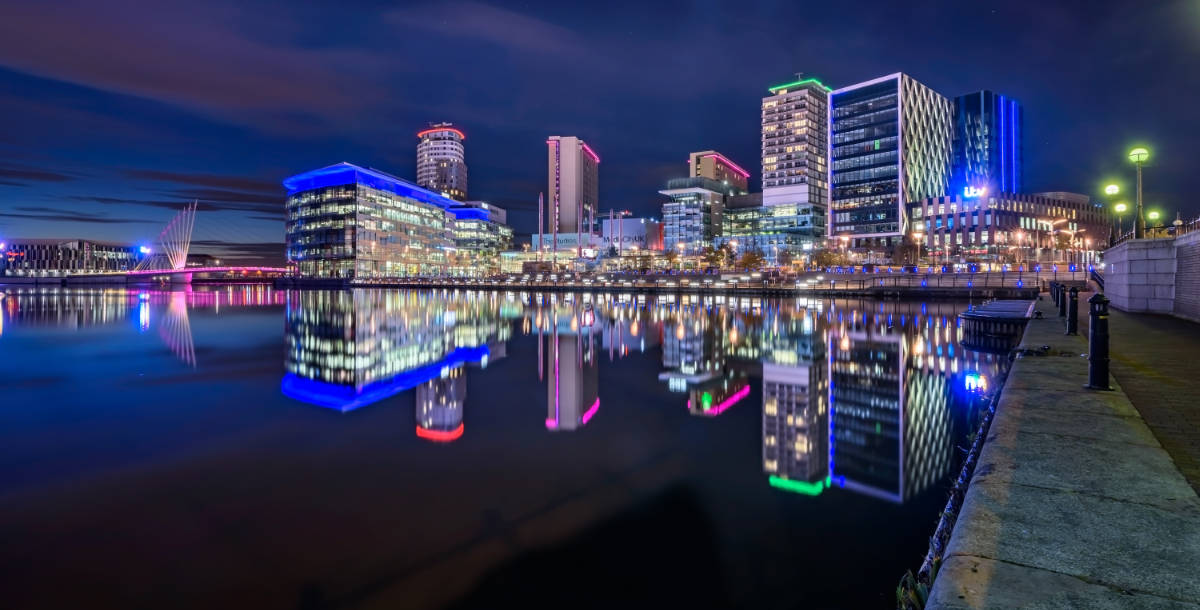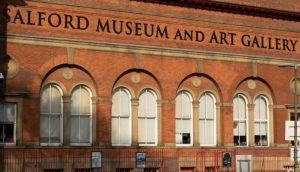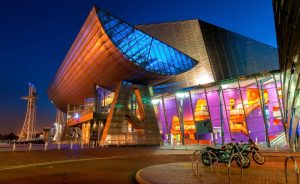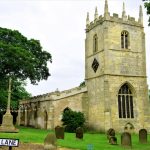
Salford lies to the west of Greater Manchester and lies on the banks of the River Irwell. This 39-mile river is a tributary into the Mersey, which was once the most important trade route for the whole of Manchester. Although this might not be true any longer; this city is one of growth, of riverside beauty, and of fishermen… for rather obvious reasons.
Although technically not its own county seat, Salford was historically given judicial powers as one of the hundred of Salfordshire. This was an ancient judicial system of rule, preceding the city by about 800 years. You see, Salford has been around for a while… but it hasn’t always been a city.
We took the Five Minutes Spare spin over Salford to find out why something so ancient wasn’t made into an official city until 1925. There’s something funny going on there, and we intend to find out what it is.
Salford in the Early Days
Before recorded history began there are thought to have been residents in Salford, or at least the surrounding area. There have been finds of Neolithic arrows, tools and other archaeological pieces. The interesting thing about all of this is that the materials the items were made out of are not readily available in the area. Perhaps the Neolithic men and women were also using the river for trade… A bronze age cremation urn was also found nearby in the 19th century.
The earliest recorded history of this area is in the Anglo-Saxon Chronicle of 923. Back in those days, the Danes hadn’t invaded just yet. It was around this time that they took the whole of what is now known as northern England. In actual fact, the Kingdom of Northumbria and the fort of Bamburgh.
From the early 7th century the entirety of north England joined up under the kingdom of Northumbria. It also extended to include the parts of Scotland that could be taken. Legend has it that the barbarians to the north were constant raiders into these lands because it was far easier to steal from the Northumbrians than it was to risk a clan war. Numerous cattle were stolen, and the two sides were at constant war.
As well as the Scots, Northumbria had to contend with the Vikings. When they started to arrive the kingdom was bordered on the south by Mercia. It is likely that it held land as far north as the Firth of Forth… the actual name ‘Northumbria’ literally translates to the people to the north of the Humber.
Anyway. Northumbria was a religious kingdom that very much held onto the relics of the past. It is said they had the body of St. Cuthbert, among other things. They resisted Danish rule for hundreds of years, holding out even better than any other part of England…. Mainly because of the huge fort at Bamburgh. This was the residence of the leaders of Northumbria and was known as being one of the most impenetrable forts ever built in England. The Danes did take it, but it wasn’t until 993.
When the Vikings came, they destroyed most of the fortifications – but the castle still stands to this day. The castle went on to undergo a revolt in 1095. It is only after this revolt that Northumbria amalgamated with the other principalities (Mercia, Wessex, and a few others) to ultimately become England as we know it today…
…So Salford has more of an active interest in the history of the UK than you might think…
As an aside… When the Vikings finally did take Bamburgh they subjected the leader to one of the most torturous ‘eagles’ ever recorded. This is a gruesome method of killing that is best left to the annals of time. If you are really interested (you macabre monster) you can find out more about them, here.
Salford – What’s in a Name?
Salford was named after the Salfordshire Hundred. This was a stretch of land that ran from Mersey to Rossendale. This area covered a hundred different little places, all of which fell under that one banner. The Hundred eventually became southern Lancashire. It is mentioned in the Domesday Book (which covered a survey of landowners) as having 21 separate areas of woodland, all split up between their own thegns. Basically, the Salford area in 1066 had more leaders than it had peasants. If you were born in Salford, you are probably descended from a landowner or a Danish warlord. Nice.
Around 1086 – only a handful of years after the Norman invasion, William the Conqueror took possession of the lands and started to rid himself of all that competition. For three centuries the lands went back and forth between kings and counties. It was at this initial junction that Manchester was birthed by one Roger de Poitou.
In the old tongue, Salford means the fjord with the willow trees. It is thought that the fjord was covered by the Victoria Bridge in the end. This is where the early town started to spring up. It is thought that an early tribe from the area had a fortified camp where Manchester Cathedral now stands and that their territory would have covered and included Salford.
When the Romans invaded around 80AD they built the fort at Manchester, and then they built two straight roads… one south, one west. The west road ran straight through Salford and made use of the bridge. When the Romans left in the fifth century, they left little to remember them by… except for a whole city. Manchester sprung up, Salford grew as a commuter town and was ultimately at the mercy of the invading Vikings and Normans when they later came.
It was after the establishment of England as a whole that the Hundred were introduced. It continued to grow as a manor town until the 12th century when the king finally recognised its value as a market town.
The 12th Century Salford
Now. Through a series of complex, some might even say ‘idiotic’ changes of hands; the title of Lord of Salford always belonged to the Duchy of Lancashire, therefore meaning it is owned by the crown. There has always been a manor here, ever since the years of the Hundred. During the civil war, they were supporters of the Royalists. The first battle against the British army took place on Victoria Bridge. At the time, it was the only bridge across the River Irwell.
The siege of Manchester saw the town used by troops as a sort of stop-over point. It was a small place with a small industry. Bleaching, dyeing, silk and wool weaving were all common here. It was granted the right to have a market and call itself a town in 1228 by Henry III. Two years later the 6th Earl of Chester made it a Borough. Interestingly, one of the town’s rules was that you weren’t allowed to work in Salford unless you lived there… To this day, we don’t think that rule has been redacted.
Salford grew to be a wealthy area in the middle ages. Before the siege of Manchester and the civil war ever hit it was recorded as having 30 manor homes within a 5-mile radius. There were mansions everywhere. Obviously, it was very good farming land.
The Civil War saw Salford firmly landing on the side of Bonnie Prince Charlie; an attribute most often found north of the border in those days. The Siege of Manchester was launched from Salford, so the two towns were more than a little peeved with one another. Prince Charlie was anointed in Salford by a minister, only to come back without his army after nine days. The residents of Salford sped him north where he eventually fled to Sky.
The 17th Century Onwards
Salford was always a textile town and with so many manor houses in the area, it was doing pretty well already when the Industrial Revolution hit. They were famed for exporting woollen goods and Fustians; which are thick fabrics generally woven from cotton to make working clothes. After the Silk Road was established, they had a bit of a head start, and silk was funnelled here to be treated.
Towards the 18th century, these skilled workers were renowned up and down the land – and that attracted the factory builders. Manufacturers built cotton mills using the water of the river to work. The majority of these were built on the Manchester side of the river, though. Effectively, the only thing that halted Salford from becoming as big a city as Manchester was the currents of the river. They were simply stronger upstream.
The Twist Mill was built at the turn of the century, allowing a second claim to fame for the town. Salford was home to the second multi-storey iron structure to be built in Britain. A few years later, this same mill became the first to use gas lights. After the Bridgewater Canal was built, trade increased, and coal costs dwindled. The town became fully immersed in the industrial revolution, with its main interest being in cloth production.
Population Spurt
Between the end of the 18th century and the beginning of the 20th, Salford went from a population of about 7,000 to a population of more than 200,000. In 1894 they built their own docks, later to merge with Manchester docks before Land Laws prevented Urban Sprawl. Karl Marx spent time here studying the workers, almost all of which were involved in textile production. In 1844 a colleague of his recorded it as ‘dirty and dilapidated.
In 1844 it was granted another charter, this time for incorporation. The first College was opened here forty years later but has been rebuilt several times before becoming the University we know of today. Around 1840 politicians finally started to realise the potential of this little town, and soon the streets were filled with dockworkers and weavers. The world-famous rugby club, the Salford Reds, was established in 1879. Unfortunately, so much growth happened so fast in Salford that the social situation could not keep up. There were 80homes per acre at one point, with terraced housing built for most of the poor.
There was no lighting, no sewerage works, and no real roads. Middle-class women started to build their own roads out of town. They moved to estates and left the squalor behind them… as you can imagine, disease shortly followed.
Plagues, Cholera, and the World at War
The plague came to the Manchester area in 1348-9 as it did in every other town. It also came again, again and again throughout the years. In the 1580’s it was reported, then again in the 1590s. In August 1605 there was not a single christening in the area because all the newborns were dead. More than a thousand burials were recorded during 1605. In those days that might have been as much as half of the population.
In response to the high death toll in the 17th century, Manchester City Council went ahead and charged a tax for each head that was infected with the plague. No joke. This led to rife mis-recordings of deaths. For example, Salford parish reported 15 deaths in September of 1605, only 11 of which were of plague. The following month there were five deaths, with only three being recorded as plague. It is widely believed the numbers are not to be trusted.
If you want to read more about plagues and epidemics throughout the middle ages and around this specific area, HSLC is a great source of information.
During every single English war, residents of Salford have stepped up and fought. They raised four Pals Battalions. In a single day, they were wiped out as they attacked the German front lines. They lost approximately 1,000 young men in that one day. To this day, it is remembered as Thiepval Day. It was a genuine modern-day tragedy. Luckily for Salford, they are right next door to Manchester and escaped most of the bombings. At least the home front was secure, even although they lost so many lives.
Now that we have covered the history of this remarkably brave little textile town; let’s talk attractions. If you were to spend some time here, what should you get up to? Let’s find out…
Attractions in Salford
Salford is so close to Manchester that you have access to some of the attractions on the opposite banks of the river. Salford itself doesn’t come up short, either. Here are some of our favourite things to see and do around town…
History and Landmarks
The Manchester Cathedral is still standing, still in use, and still as hauntingly beautiful as it was back in the 16th century. You can visit it to take Instagram-worthy pictures, or you can wander the gorgeous grounds to breathe in the tranquillity of the gardens. The cathedral itself is still in use so you ought to hear the bells on a Sunday. Get a good look at the stained-glass windows they are straight-up perfect.
Historically speaking, Salford is the district of manor houses. You can visit the Castlefield Urban Heritage Park, Ordsall Hall, which gives a long history as far back as 1107, or the Tudor Bramall Hall. There is also the stately Tatton Park, Lyme Park manor, Wythenshawe Hall, and Heaton Hall… you get the idea. If stately homes in the country are your thing you just check in to your lodgings and go for a drive or walk.
Galleries and Museums

Image: John B Hewitt/Shutterstock.com
The National Football Museum was created to honour the 1966 world cup win that England brought home. This end of the country loves their football, so where better to put this particular museum? Manchester Museum is a firm second favourite with local schoolchildren. They have the skull of the world’s oldest horse. You also have Chetham’s Library, with its vast collections, if you want a little extra culture.
Other notable museums include the Science and Industry Museum and the Imperial War Museum for the north.
Manchester Art Gallery is the best place in England to learn about pre-Raphaelite Art. We hope this means something to one of you as Art History is not the writer’s strong point. If you prefer, the Whitworth Art Gallery has been making money in the area for a very long time. As far as culture is concerned, Salford and Manchester come together to cover every base.
Sports and Leisure Salford Attractions

The Lowry Gallery & complex is a stunning sight, especially at night!
Image: SAKhanPhotography/Shutterstock.com
The Media City. It’s a weird and wonderful, futuristic digital part of the city that on its own justifies a trip to Salford. We like it so much that we used it as the header image! Close behind comes the Lowry which is located down on the quays. This is a theatre/art gallery which always has something going on. A trip to see 5this can be combined with a few hours at the quays which have plenty of bars, places to eat, and other attractions down there.
Kids Attractions in Salford
What if you need to keep the kids entertained? We hear you ask. Try these…
The East Lancashire Railway has a cute steam train that they will love. It’s not the cheapest but it is a firm favourite. Inflata Nation is one of the biggest indoor play parks around and is well within reach of Salford. If you really want to inspire some smiles take them on the CBBC tour at MediaCity. Legend has it there is a Crystal Maze escape room type place in the city. If you manage to find it, let us know how it goes…
Where to Eat, Drink and Party in Salford?
If you want some fun family food, the Flaming Grill is a great start. Monty’s offers excellent pizza if you are taking the kids out to eat. If you would prefer more upmarket, traditional dining, Harry Ramsden has a restaurant here that is worth its reputation in gold… although they do like to pretend they are Manchester-based, instead of Salford-based. If you want a high-class meal try pier 8 for size.
As to the drinking and partying aspects, the best cocktails are to be had at Alchemist Media city. There is a lovely bodega on Eccles road that is the best place for wine tasting… For dancing the night away though, try the Washhouse, or Lock 91 for a more underground scene.
Salford has a bit of everything plus proximity to Manchester. They are one and the same when it comes to nightlife. You will find something in town that suits you.
How To Get To Salford
So now we have told you everything – except how to get to the dang place.
By Road
Head West out of Manchester city on the M/A 57 and you should hit Salford soon. Similarly, if you are driving up from London, follow signage for Manchester then carry on through the city to the west.
By Rail
Head out of Manchester for the Salford Central Station. Again, if you are heading up from London or down from Edinburgh you may need to hop off at Manchester, and then back on a connecting train.
By Air
Salford has a city airport and helipad but it isn’t for us peasants. Try flying into Manchester Airport and jumping on a train, instead.
By Sea
You can get to and from Salford by using the Manchester Port, it is one and the same.
Got Five More Minutes?
If you still have a little spare time to waste, then look no further. We are able to provide more than enough information on any subject you care to master. Stop by Five Minutes Spare HQ and learn something new. You never know, you might even have a little fun doing it!


